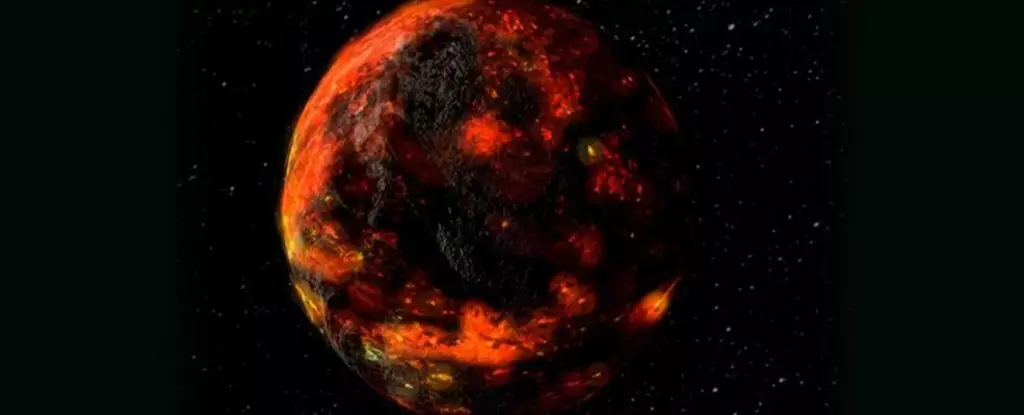The Moon has captivated humanity’s imagination for centuries, serving not only as a guiding light in the night sky but also a subject of scientific intrigue. Recent advancements in lunar geology have opened new frontiers in our understanding of this celestial body’s early history. Despite considerable knowledge amassed through decades of study, particularly from the Apollo missions, researchers continue to peel back the layers of the Moon’s genesis. A significant breakthrough was highlighted by scientists, including Nicolas Dauphas from the University of Chicago, who have determined that the Moon solidified approximately 4.43 billion years ago, coinciding with Earth’s transformation into a habitable planet.
The Impact That Shaped the Moon
The formative hours of the Moon’s existence are deeply interwoven with the chaotic environment of the early Solar System. It is believed that a colossal impact, possibly from a Mars-sized entity dubbed Theia, sent molten and fragmented debris spiraling into space, forming what we now recognize as the Moon. This primordial body was initially a molten mass, dramatically shaped by intense gravitational forces and subsequent cooling processes. As the molten proto-Moon cooled, it formed distinct layers, a characteristic that has profound implications for the Moon’s geological make-up.
In a groundbreaking study, researchers focused on the remnants of the Moon’s magma ocean, which resulted from these early stages of solidification. They examined the elemental makeup of lunar rocks, particularly a unique residual liquid known as KREEP (an acronym for potassium, rare earth elements, and phosphorus). This particular composition provides a crucial perspective on the Moon’s cooling timeline and evolution, and its examination marks a pivotal moment in lunar research.
KREEP not only carries with it a signature elemental mix, but its formation signifies a critical epoch in lunar geological history—approximately 140 million years after the Solar System’s birth. This research hinges on the study of “lutetium,” a rare earth element that decays into hafnium over time, causing scientists to probe deeper into lunar rock samples for insights. By comparing the ratios of these elements in Moon rocks with other celestial bodies that formed around the same era, researchers can draw conclusions about KREEP’s timeline and its implications for lunar geology.
The findings illustrate that, while the majority of the lunar magma ocean solidified, the KREEP remnants represented a concentrated and distinct part of this cooling process. Through painstaking analysis of lunar zircons embedded in rock samples, the research team confirmed that the age of these rocks aligns with the hypothesized timeline of lunar development, giving fresh life to long-standing theories regarding the Moon’s cooling off period.
As researchers delve further into the complexities of Moon rock analysis, intriguing questions arise about the environment in which the Moon developed. The process of crystallization of the lunar magma ocean coincided with bombardments from leftover planetary fragments that were lingering in the solar vicinity, which played a defining role in shaping the Moon’s surface. It is a vivid image that encapsulates the intense and chaotic nature of our celestial neighborhood during the early stages of planetary formation.
The significance of this study extends beyond the realm of lunar history; it resonates with our understanding of Earth’s evolution. The same impacts that contributed to the Moon’s formation likely had profound effects on early Earth, possibly marking the last major collision that shaped our planet’s geology. As the early Earth began to stabilize, it laid the groundwork for a hospitable environment—a crucial development in the evolution of life.
The saga of the Moon’s history not only relies on the research conducted thus far but also hinges on future explorations. Upcoming missions, such as those anticipated under the Artemis program, hold the promise of uncovering new geological samples and insights. The South Pole-Aitken basin, a site that has sparked interest among scientists, offers an avenue for re-evaluating existing findings and reshaping our comprehension of lunar volcanic activity, including the formation of mare basalts. These basalt layers arose in response to late-stage impacts and provide additional context for the Moon’s dynamic history.
Ultimately, the insights garnered from studying the Moon’s early formation and its KREEP layers facilitate a better understanding of both lunar and terrestrial evolution. As Dauphas aptly summarizes, ongoing research enmeshes our quest for knowledge about the Moon with our curiosity about Earth, illuminating the connections between our two celestial neighbors. Each discovery we make at the Moon adds another piece to the intricate puzzle of our cosmic story, driving a deeper appreciation for the universe we inhabit.


Leave a Reply